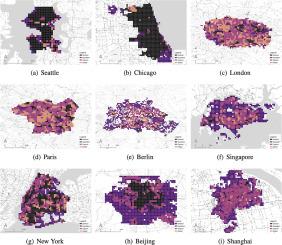Computers, Environment and Urban Systems ( IF 7.1 ) Pub Date : 2021-08-21 , DOI: 10.1016/j.compenvurbsys.2021.101706 Wangyang Chen , Abraham Noah Wu , Filip Biljecki

|
There is a prevailing trend to study urban morphology quantitatively thanks to the growing accessibility to various forms of spatial big data, increasing computing power, and use cases benefiting from such information. The methods developed up to now measure urban morphology with numerical indices describing density, proportion, and mixture, but they do not directly represent morphological features from the human's visual and intuitive perspective. We take the first step to bridge the gap by proposing a deep learning-based technique to automatically classify road networks into four classes on a visual basis. The method is implemented by generating an image of the street network (Colored Road Hierarchy Diagram), which we introduce in this paper, and classifying it using a deep convolutional neural network (ResNet-34). The model achieves an overall classification accuracy of 0.875. Nine cities around the world are selected as the study areas with their road networks acquired from OpenStreetMap. Latent subgroups among the cities are uncovered through clustering on the percentage of each road network category. In the subsequent part of the paper, we focus on the usability of such classification: we apply our method in a case study of urban vitality prediction. An advanced tree-based regression model (LightGBM) is for the first time designated to establish the relationship between morphological indices and vitality indicators. The effect of road network classification is found to be small but positively associated with urban vitality. This work expands the toolkit of quantitative urban morphology study with new techniques, supporting further studies in the future.
中文翻译:

基于深度学习的城市形态分类:在城市活力中的应用
由于各种形式的空间大数据的可访问性越来越强,计算能力的增强以及从这些信息中受益的用例,定量研究城市形态是一种普遍趋势。迄今为止开发的方法用描述密度、比例和混合的数值指数来衡量城市形态,但它们并不能从人类的视觉和直觉的角度直接表示形态特征。我们迈出了弥合差距的第一步,提出了一种基于深度学习的技术,可在视觉上自动将道路网络分为四类。该方法是通过生成我们在本文中介绍的街道网络(彩色道路层次图)的图像,并使用深度卷积神经网络(ResNet-34)对其进行分类来实现的。该模型实现了 0.875 的整体分类准确率。选取全球 9 个城市作为研究区域,其道路网络从 OpenStreetMap 中获取。通过对每个道路网络类别的百分比进行聚类,可以发现城市之间的潜在子组。在论文的后续部分,我们将重点关注此类分类的可用性:我们将我们的方法应用于城市活力预测的案例研究。一种先进的基于树的回归模型(LightGBM)首次被指定用于建立形态指标和活力指标之间的关系。发现道路网络分类的影响很小,但与城市活力呈正相关。这项工作用新技术扩展了定量城市形态研究的工具包,支持未来的进一步研究。











































 京公网安备 11010802027423号
京公网安备 11010802027423号